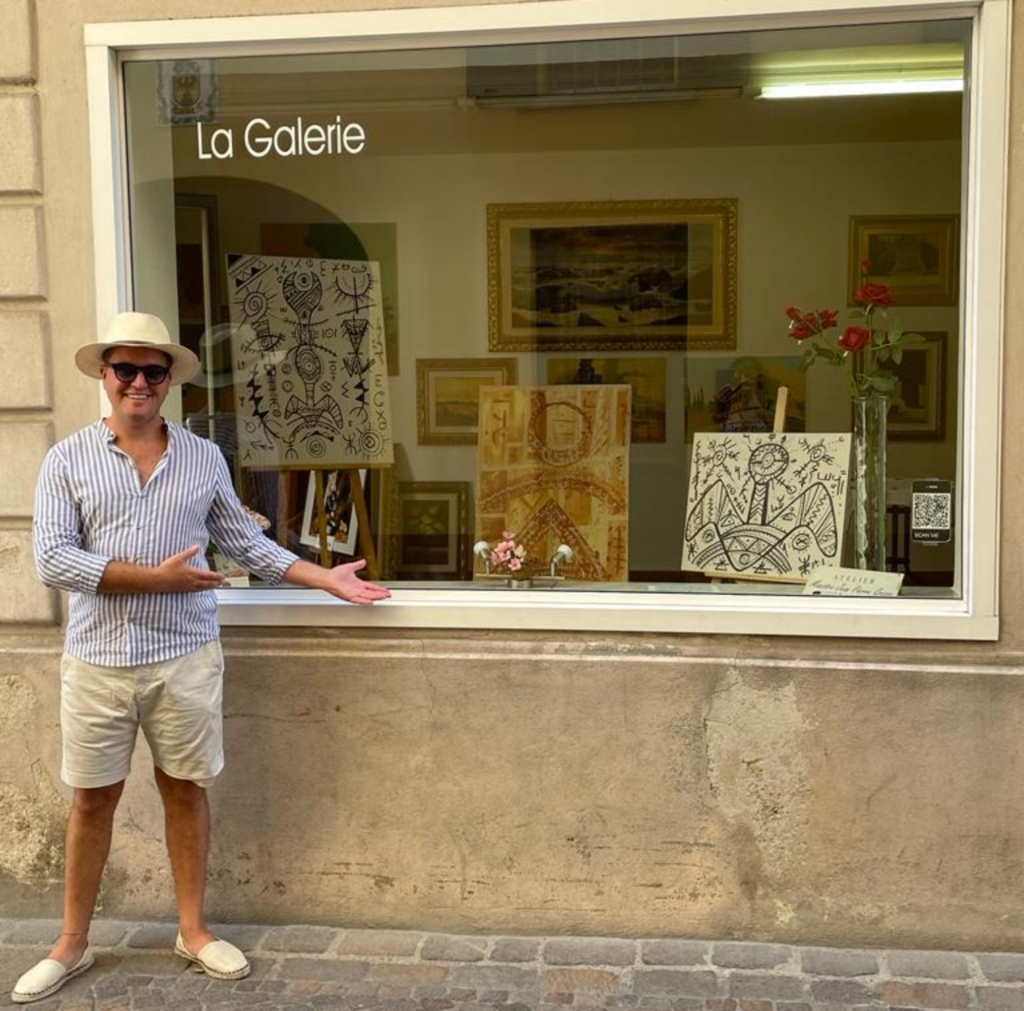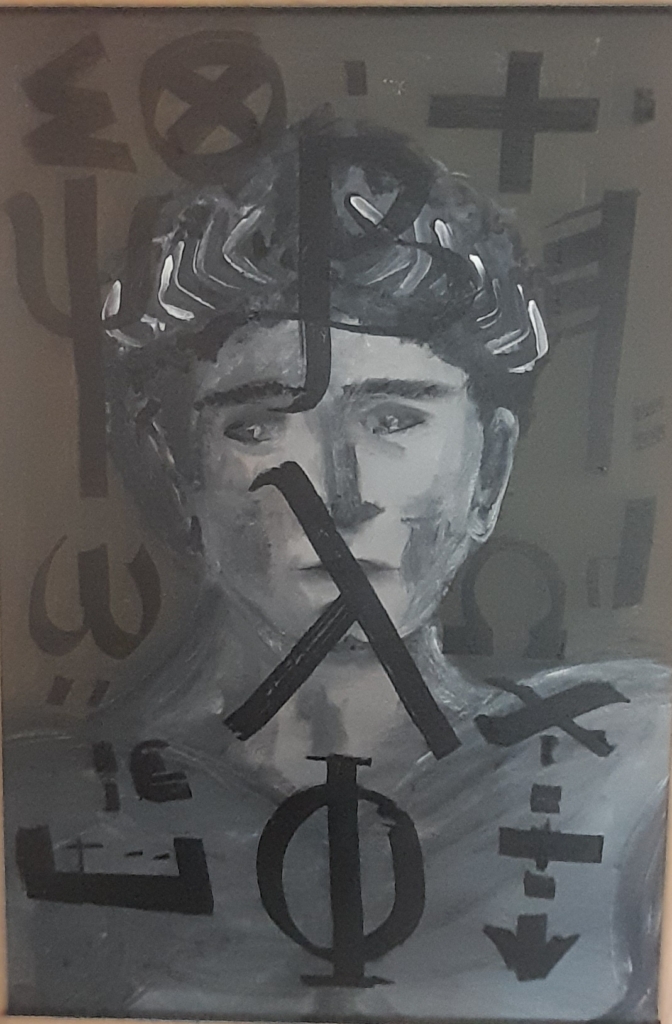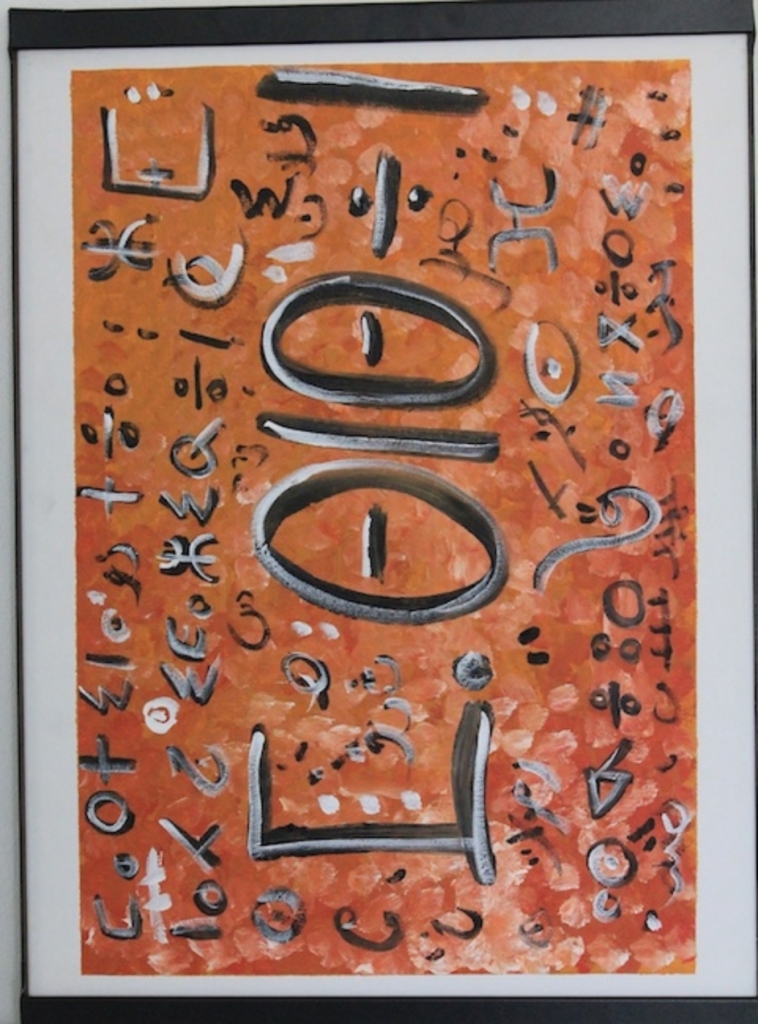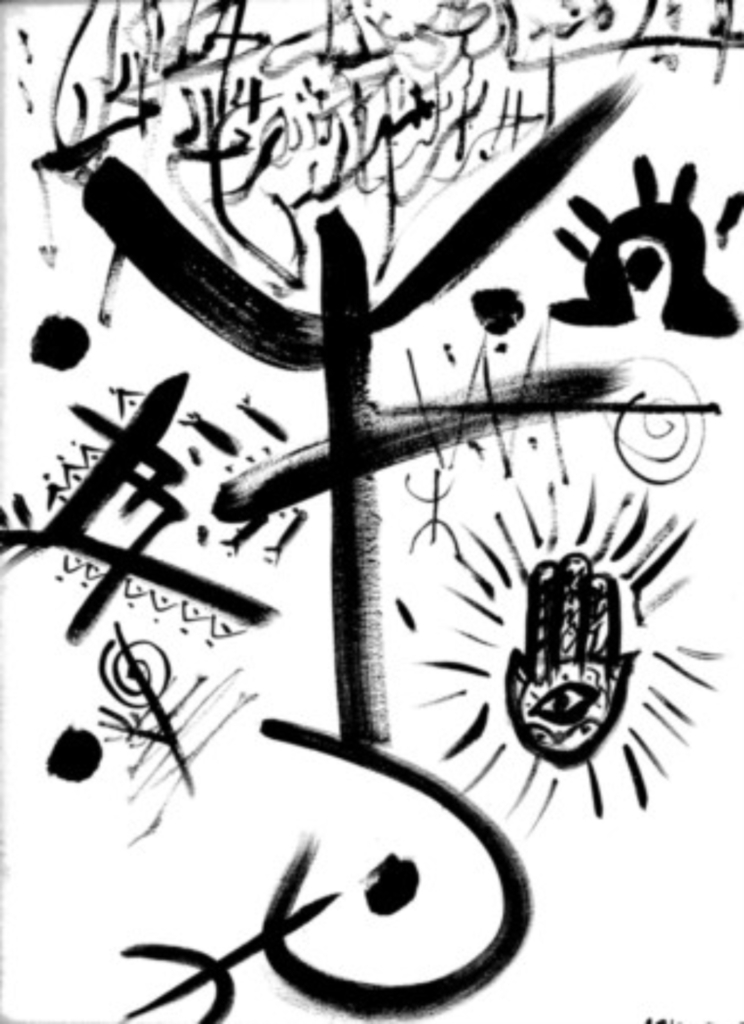di Marta Lock

Le origini berbere hanno determinato la sua indole girovaga che lo ha portato fin dalla giovane età a seguire il padre, medico, attraversando i paesi del Nord Africa ed entrando così in contatto con culture diverse dalla propria che lo hanno affascinato e che hanno accresciuto il suo patrimonio conoscitivo; da quelle nazioni così eterogenee ha appreso e assorbito caratteristiche e tradizioni che ha riposto in uno scrigno della memoria costituendo la base della sua apertura empatica e dello stile che successivamente avrebbe contraddistinto la sua espressione artistica. Terminati gli studi umanistici non poteva non seguire, ancora una volta, l’istinto e il desiderio di scoperta che lo ha spinto a viaggiare per tutta Europa e nel bacino del Mediterraneo, appassionandosi di arte, filosofia greco-romana e storia, interagendo con ulteriori culture, differenti dalle precedenti già scoperte, ma tutte essenziali a generare il substrato culturale che ha formato la sua personalità rendendolo un dinamico ed eclettico personaggio in cui la curiosità e l’attitudine imprenditoriale si sono concretizzati in attività variegate in cui ha coniugato il profondo amore per la natura e quello per l’arte. Stabilitosi in Italia decide di creare una linea di orologi, Napoleon Watches, per cui ha ricevuto un riconoscimento da parte del Consolato d’Algeria, suo paese di nascita, di Milano e che gli hanno dato notorietà e successo; poco dopo scopre di non voler essere solo un appassionato contemplatore delle bellezze artistiche così decide di dar vita a uno stile figurativo in cui potesse raccogliere ed esprimere tutto ciò che i suoi occhi hanno visto e ammirato in passato, pur legandosi a una realtà stilizzata, non lontana dalle antiche iscrizioni rupestri, poi riprese da alcuni esponenti della Street Art, in cui fonde il concetto con l’immediatezza di un’immagine decorativa vicina ai segni primordiali, ai primi segnali di linguaggio che erano principalmente simboli di un concetto, suggerimenti ermetici su ciò che non poteva essere chiarito se non attraverso la semplificazione del disegno. La scelta di mescolare le sue conoscenze e di produrre opere quasi esclusivamente in scala di grigi contribuisce a dare un’intensa personalizzazione alle opere di Massinissa Askeur, un voler sottolineare l’importanza dell’essenza di fronte a un mondo che invece rincorre solo l’apparenza; in qualche modo ripercorre il cammino degli avi, di quei popoli capaci di vivere un rapporto più diretto con la natura e di interfacciarsi in maniera più spontanea, spogliata dalle complicazioni della modernità pur senza escludere però gli enigmi, i misteri che hanno da sempre indotto i popoli ad andare verso la conoscenza. La tela Patrimoine berber (Patrimonio berbero)

è piena di simboli, sembra essere un terreno di mezzo tra graffiti antichi e la Strett Art segnica, quella in cui era più necessario nascondere che non rivelare, quella attraverso la quale tutto ciò che non era in grado di essere espresso a parole o in una società troppo spesso discriminatoria, doveva essere comunque espresso; Massinissa Askeur rende invece i segni un messaggio di comprensione spontanea, solo osservando i piccoli dettagli si possono scoprire quelle allusioni, quei significati sussurrati che sono ricollegabili al patrimonio berbero a cui accenna nel titolo. Le sue tradizioni sono talmente radicate in lui da volere al contempo renderle protagoniste ma anche farle conoscere al resto del mondo che, anche quando si trova vicino geograficamente, ne ignora il fascino e la bellezza. Anche l’opera Ancestrale

si propone come un modo per mantenere vivo un linguaggio primordiale, quasi un codice che appartiene al passato eppure non può e non deve non trovare più spazio nel presente, perché il legame con ciò che costituisce le proprie radici deve rimanere saldo e indelebile nella memoria tanto quanto deve costituire il terreno su cui costruire ed edificare la propria vita. Attraverso le domande di questa intervista potremo scoprire di più di questo eclettico artista.
Massinissa, il suo percorso di vita è stato decisamente affascinante poiché ha deciso di lasciare l’Algeria, il suo paese di origine, per scoprire altri luoghi dove poi ha costruito il suo futuro. Quanto è stato importante il suo cammino di conoscenza per la formazione del suo carattere e del suo approccio pittorico? Quali sono i paesi che hanno lasciato un solco più profondo nella sua interiorità e perché?
Non possiamo parlare di Ercole senza citare le sue fatiche, di Ulisse senza ricordare i suoi viaggi, o di Cesare senza citare le sue conquiste. Come tutti loro anche io ho affrontato la mia traversata del deserto che ha fatto di me l’uomo che sono adesso, sia dal punto di vista stilistico sia da quello umano. Mi è sempre piaciuta la frase di un filosofo francese che dice che “l’autoctono è solo un immigrato di più lunga data”. Mi sono sempre sentito una sorta di fotografo del tempo sentendo il bisogno di dipingere tutto ciò che vedevo ma soprattutto tutto ciò che sentivo perché la cosa più difficile è di riportare su una tela uno stato d’animo. E questo non è così semplice perché non si tratta di riprodurre un paesaggio che uno può immaginare o copiare dal vivo. Ho riscontrato nel tempo una grande somiglianza tra le tradizioni e le culture nel Mediterraneo, malgrado l’unicità di ognuna dunque è importante mescolare e mettere in risalto dettagli di ciascuna di loro nella mia espressività pittorica. In merito al paese che mi ha conquistato più di ogni altro mai visto durante i miei viaggi, la mia risposta è sempre la stessa, l’Italia con la sua storia, la cultura, la cucina, l’architettura e i paesaggi più sorprendenti del mondo, senza parlare del Rinascimento, l’impero romano, gli Etruschi, le isole con la loro storia affascinante come la Sicilia o la Sardegna. Solo per la Sardegna, mi potrei fermare a parlare per ore, dalla rivolta di Amsicora alla scrittura primitiva incisa sulle rocce.

Imprenditore a tutto tondo, creativo per vocazione. Ci racconta la sua esperienza come ideatore della linea di orologi Napoleon Watches e come cinofilo, la sua altra attività? Tra tutti questi impegni, oltre a due figli e una moglie, quando riesce a dedicarsi alla pittura?
Vedere le proprie opere o disegni materializzarsi è tutta un’altra cosa e, soprattutto, un’altra energia, perché si può toccare fisicamente un’idea che è nata da un disegno. Ho sempre amato il design e il mondo degli orologi e, nel 2016, ho deciso di creare quattro modelli classici curandone tutti i particolari. È stata la mia prima esperienza con il design e direi che ne sono molto soddisfatto. La cinofilia è un’altra passione che ho sempre avuto sin da quando ero piccolo. Ho sempre amato i cani e ne ho sempre avuti, per cui ho deciso di aprire il primo posto in Italia dove i cani possono stare liberi senza gabbie. Si tratta di una sorta di albergo per cani con prati e bosco privato, il tutto pensato a partire da un approccio zooantropologico che pone il cane al centro dell’attenzione e lo pensa come individuo unico e irripetibile. Per quanto riguarda il tempo da dedicare all’arte, sono riuscito a trasmettere la mia passione anche ai miei figli, perciò mi trovo spesso a dipingere in famiglia.
Arriviamo ora all’aspetto più propriamente creativo: cosa desidera comunicare all’osservatore con le sue opere? Qual è il messaggio che vorrebbe fuoriuscisse? E quanto è importante mantenere il legame con il passato per vivere il presente?
Ho sempre cercato di spiegare all’altro che tutti siamo uguali, che abbiamo le stesse paure, gli stessi obiettivi e le stesse sensibilità e che non c’è modo migliore di usare un linguaggio di quanto fatto dall’uomo delle caverne o dall’uomo sapiens che poteva essere compreso da tutti, come espressione universale senza creare barriere di religione o di cultura. Come dicevo prima, possiamo percepire nel qui e ora la stessa sensibilità che ha avuto un essere umano che ha vissuto migliaia di anni fa attraverso i suoi disegni lasciati incisi in una roccia in qualche angolo remoto di questo mondo, e questo linguaggio è così profondo da raggiungere sia la mente che l’anima, andando a risvegliare una memoria molto primitiva che abbiamo seppellito in profondità. L’uomo ha sempre cercato, nella sua terra e nei suoi antenati, un conforto che ha rappresentato una prima forma di religione e anche di aggregazione. Da qui, la genialità dei simboli che non vanno a rimandare a una lingua particolare ma a una sorta di globalizzazione che ci fa capire che dobbiamo ragionare come umanità e non come individui, paesi, religioni. Invece è molto importante conoscere la propria storia per poterla raccontare agli altri. La forza dell’umanità è sempre stata la sua diversità, non solo quella fisica o culturale ma anche quella intellettuale. Ognuno porta il suo bagaglio per formare un sapere più grande che potrà essere beneficio per l’umanità intera.

Lei è stato un grande appassionato d’arte prima di diventare un artista, quali sono i maestri del passato che l’hanno ispirata? E quali quelli a cui si sente più vicino per intento creativo anche se lo stile può risultare apparentemente diverso?
Io ho sempre apprezzato tutte le forme dell’arte ma dal punto di vista stilistico sono sempre stato attratto da Joan Mirò e dalla sua capacità di ideare forme e simboli quasi come un linguaggio segreto. Infatti per me è stato un grandissimo onore ricevere un premio durante il Festival di Cannes come erede dello stile di Mirò. E poi tanti altri artisti come Guttuso, Frida Kahlo, Picasso… credo che tutti questi maestri mi abbiano arricchito e aiutato a trovare il mio stile che richiama un po’ tutti questi grandi nomi del Ventesimo secolo.

Le sue opere saranno esposte in permanenza a partire dall’8 luglio presso lo spazio espositivo La Galerie di Caslano, in Svizzera, oltre ad avere spazio alla Biennale di Venezia e al Carrousel du Louvre; recentemente è stato inserito nell’Annuario dell’Arte Contemporanea Artisti ’22 edito da Mondadori. Ci racconta quali sono i suoi prossimi progetti?
Cerco di rimanere sempre dinamico, sono appassionato della vita e di tutto ciò che riesce a offrirmi e per questo mi avventuro su tanti terreni come la politica, il collezionismo e anche l’ipnosi e varie tipologie di introspezione per approfondire le mie conoscenze sull’essere umano e la sua psiche. Mi piacerebbe scrivere un libro nel futuro prossimo. Per quel che riguarda il design ho vari progetti in fase di ideazione, come stampare le mie opere su vestiti in collaborazione con stilisti di fama internazionale. Per il resto, il mio progetto più grande è di fare il papà per Noah e Théa.
MASSINISSA ASKEUR-CONTATTI
Email: massinissaaskeur@gmail.com
Sito web: https://massinissaaskeur.com
Facebook: https://www.facebook.com/numidicus87
Instagram: https://www.instagram.com/massinissa_askeur/
Marta Lock’s interviews:
Massinissa Askeur, the meeting of cultures and traditions that turns into art
His Berber origins determined his wandering nature, which led him from an early age to follow his father, a doctor, across the countries of North Africa, thus coming into contact with cultures other than his own that fascinated him and increased his cognitive heritage. From these heterogeneous nations, he learnt and absorbed characteristics and traditions that he placed in a treasure chest of memory, forming the basis of his empathic openness and the style that would later characterise his artistic expression. Having completed his humanistic studies, he could not fail to follow, once again, the instinct and desire for discovery that drove him to travel throughout Europe and the Mediterranean basin, becoming passionate about art, Greco-Roman philosophy and history, interacting with other cultures, different from the previous ones he had already discovered, but all essential to generate the cultural substratum that formed his personality, making him a dynamic and eclectic character in which curiosity and entrepreneurial aptitude took the form of varied activities in which he combined a deep love for nature with that for art. After settling in Italy, he decided to create a line of watches, Napoleon Watches, for which he received an award from the Consulate of Algeria, his country of birth, in Milan, and which brought him notoriety and success; simultaneously he discovered that he did not want to be just a passionate contemplator of artistic beauty, so he decided to create a figurative style in which he could collect and express everything his eyes had seen and admired in the past, while tying himself to a stylised reality, not far removed from the ancient rock inscriptions, later taken up by some exponents of Street Art, in which he merges the concept with the immediacy of a decorative image close to primordial signs, to the first signs of language that were mainly symbols of a concept, hermetic suggestions on what could not be clarified except through the simplification of drawing. The choice to mix his knowledge and to produce artworks almost exclusively in greyscale contributes to the intense personalisation of Massinissa Askeur’s artworks, a desire to emphasise the importance of essence in the face of a world that only chases after appearances; somehow he retraces the path of the ancestors, of those peoples capable of experiencing a more direct relationship with nature and of interfacing in a more spontaneous manner, stripped of the complications of modernity without, however, excluding the enigmas, the mysteries that have always induced peoples to move towards knowledge. The canvas Patrimoine berber is full of symbols, it seems to be a middle ground between ancient graffiti and the Strett Art sign, the one in which it was more necessary to hide than to reveal, the one through which everything that could not be expressed in words or in a society that was too often discriminatory, had to be expressed anyway; Massinissa Askeur instead makes the signs a message of spontaneous understanding, only by observing the small details can one discover those allusions, those whispered meanings that are linked to the Berber heritage to which he alludes in the title. His traditions are so deeply rooted in him that he wants both to make them protagonists but also to make them known to the rest of the world, which, even when geographically close, is unaware of their charm and beauty. The artwork Ancestral is also proposed as a way of keeping alive a primordial language, almost a code that belongs to the past and yet cannot and must not find no place in the present, because the link with what constitutes one’s roots must remain firm and indelible in one’s memory as much as it must constitute the ground on which to build and construct one’s life. Through the questions in this interview, we will be able to discover more about this eclectic artist.
Massinissa, your life path was definitely fascinating as you decided to leave Algeria, your country of origin, to discover other places where you then built your future. How important was your journey of discovery for the formation of your character and your pictorial approach? Which countries have left the deepest furrow in your inner self and why?
We cannot speak of Hercules without mentioning his labours, of Ulysses without recalling his travels, or of Caesar without quoting his conquests. Like all of them, I too faced my own desert crossing that made me the man I am now, both stylistically and humanly. I have always liked the phrase of a French philosopher who says that ‘the native is only an immigrant of longer standing’. I have always felt like a sort of photographer of the time, feeling the need to paint everything I saw but above all everything I felt because the most difficult thing is to put a state of mind on a canvas. And this is not so easy because it is not a matter of reproducing a landscape that one can imagine or copy from life.
Over time, I have found a great similarity between traditions and cultures in the Mediterranean, despite the uniqueness of each one, so it is important to mix and highlight details of each one in my pictorial expressiveness.
Regarding the country that has conquered me more than any other I have ever seen during my travels, my answer is always the same, Italy with its history, culture, cuisine, architecture and the most amazing landscapes in the world, not to mention the Renaissance, the Roman Empire, the Etruscans, the islands with their fascinating history such as Sicily or Sardinia. For Sardinia alone, I could stop and talk for hours, from the revolt of Amsicora to the primitive writing engraved on rocks.
A well-rounded entrepreneur, creative by vocation. Can you tell us about your experience as the creator of the Napoleon Watches line and as a dog lover, your other activity? Between all these commitments, as well as two children and a wife, when do you manage to devote yourself to painting?
Seeing one’s own artworks or drawings materialise is another thing altogether and, above all, another energy, because you can physically touch an idea that was born from a drawing. I have always loved design and the world of watches and, in 2016, I decided to create four classic models by taking care of all the details. It was my first experience with design and I would say that I am very satisfied with it.
Dog lovers is another passion I have always had since I was a child. I’ve always loved dogs and I’ve always had dogs, so I decided to open the first place in Italy where dogs can be free without cages. It is a sort of hotel for dogs with lawns and a private forest, all designed from a zoo-anthropological approach that places the dog at the centre of attention and thinks of him as a unique and unrepeatable individual.
As far as time to devote to art is concerned, I have also managed to pass on my passion to my children, so I often find myself painting as a family.
Let’s talk now about the properly creative aspect: what do you want to communicate to the viewer with your artworks? What is the message you would like to get out? And how important is it to maintain the link with the past in order to live in the present? I have always tried to explain to others that we are all the same, that we have the same fears, the same goals and the same sensitivities, and that there is no better way to use a language than that of the cave man or the man sapiens that could be understood by all, as a universal expression without creating barriers of religion or culture. As I said before, we can perceive in the here and now the same sensitivity that a human being who lived thousands of years ago had through his drawings left engraved in a rock in some remote corner of this world, and this
language is so profound that it reaches both the mind and the soul, awakening a very primitive memory that we have buried deep within. Man has always sought, in his land and his ancestors, a comfort that represented an early form of religion and also of aggregation. Hence the brilliance of symbols that do not refer to a particular language but to a kind of globalisation that makes us understand that we must think as humanity and not as individuals, countries, religions. Instead, it is very important to know one’s own history in order to be able to tell it to others. The strength of humanity has always been its diversity, not only its physical or cultural diversity but also its intellectual diversity. Everyone brings his own baggage to form a greater knowledge that can be of benefit to the whole of humanity.
You were a great art lover before becoming an artist, which masters of the past have inspired you? And which ones do you feel closest to in terms of creative intent even though the style may appear to be different?
I have always appreciated all forms of art, but from a stylistic point of view I have always been attracted to Joan Mirò and his ability to devise forms and symbols almost like a secret language. In fact, it was a great honour for me to receive an award during the Cannes Film Festival as an heir to Mirò’s style. And then many other artists such as Guttuso, Frida Kahlo, Picasso… I believe that all these masters have enriched me and helped me to find my own style that recalls all these great names of the 20th century.
Your artworks will be on permanent display from 8 July at the La Galerie exhibition space in Caslano, Switzerland, as well as at the Venice Biennale and the Carrousel du Louvre; you was recently included in the Contemporary Art Artists ’22 Yearbook published by Mondadori. Can you tell us what are your next projects?
I try to always remain dynamic, I am passionate about life and everything it has to offer me and for this reason I venture into many fields such as politics, collecting and also hypnosis and various types of introspection to deepen my knowledge of the human being and his psyche. I would like to write a book in the near future. As for design, I have various projects in the planning stage, such as printing my artworks on clothes in collaboration with internationally renowned designers. For the rest, my biggest project is to be a daddy for Noah and Théa.
